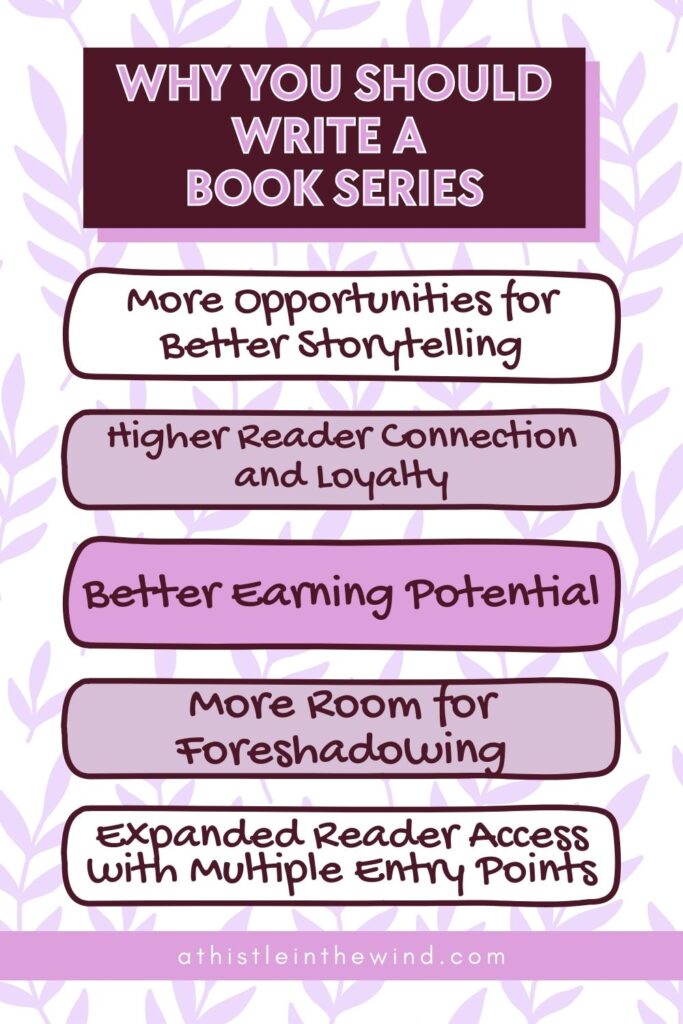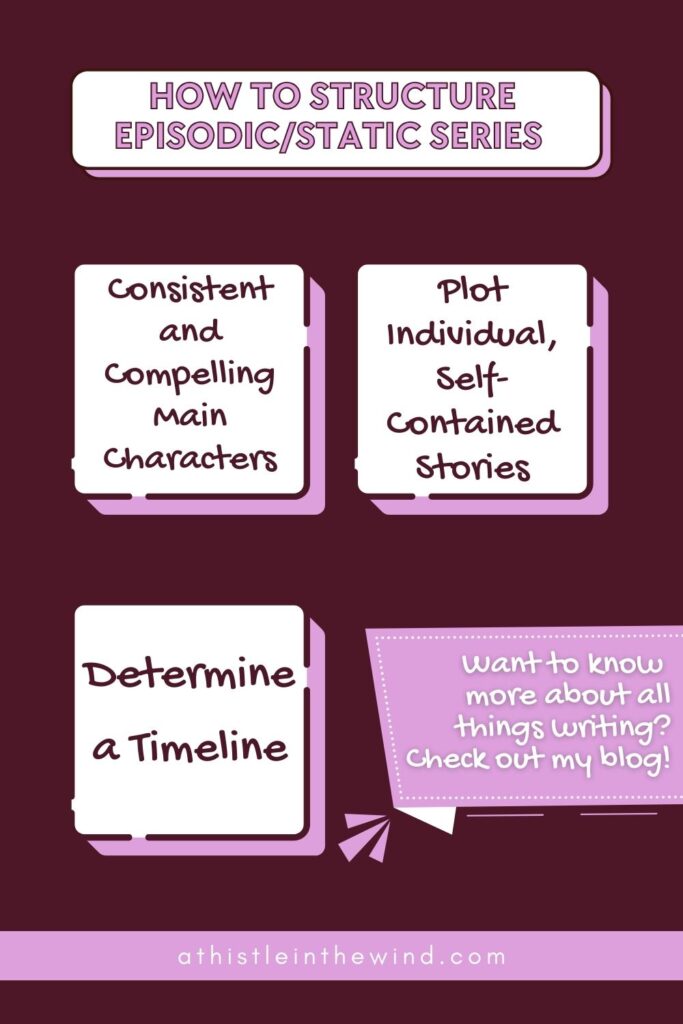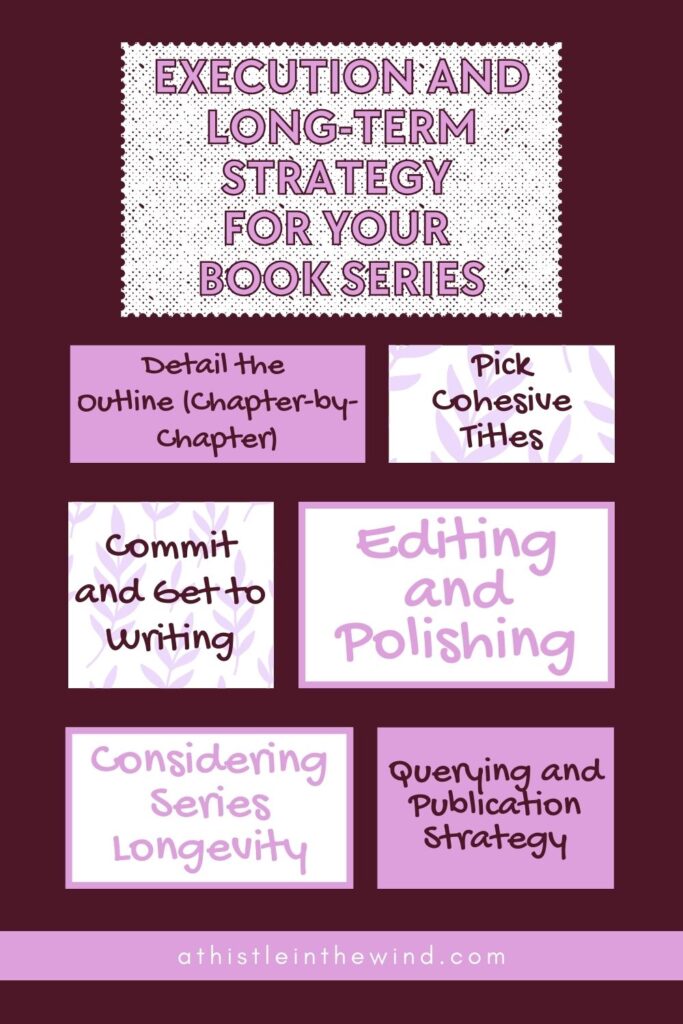How to Write & Outline a Book Series: A Step-by-Step Guide

I grew up reading a lot of book series. In fact, the very books I read, the Oxford Reading Tree series, were—cue the drum roll—a series. So was the Mallory Towers series and the wizarding world series I read (which we don’t talk about here because the author’s unhinged) well into my teens. It’s safe to say that book series have dominated a large part of my reading list.
And I bet it’s the same for a lot of you. We could talk about book series all day—maybe weeks, actually. There’s the Hunger Games, Twilight, A Song of Ice and Fire, Percy Jackson, Bridgerton, Shatter Me, and so many others. And I’m just talking about the more popular book series. When you go into specific genres, there’s a lot too; think Poirot series by Agatha Christie.
My manuscript will be the first in a series of books I want to write. Yeah, I know. There’s just something about book series that gets both readers and writers alike. But it can be quite difficult to write. In fact, I stop reading a lot of series because writers sometimes mix up events, forget about a major subplot from the previous book, or straight up ignore canon events. And that’s something you definitely want to avoid.
So, in this blog, we’re going to take a closer look at how to write and outline a book series. Let’s begin.
What is a Book Series?
If you’re wondering what a book series is—either because you’re new to writing or seven years old with a Word doc and a dream (like I was)—let’s properly define it. For those who already know, it’s fine. We’re just defining things for tech bros who think that you messed up if you wrote a book. And yes, that is something someone very (in)famous has said in the past (I weep for the future of humanity being in the hands of tech bros).
Anyway, according to the Britannica Dictionary, a [book] series is:
a set of books, articles, etc., that involve the same group of characters or the same subject
Book series aren’t limited to fictional books either. There are plenty of nonfiction and encyclopedias that come under this category too. But for the context of this blog, we’re talking purely about fiction books. So, this includes genres like romance, thrillers, fantasy, and anything you’re into, really.
Why You Should Write a Book Series
Now that we know what a book series is, let’s look at why you should write one. Let’s be real: writing a book series is a massive undertaking, but its benefits—both creative and commercial—make it worth your while.
Here are five compelling reasons why you should write it.
1. More Opportunities for Better Storytelling
If you find that your ideas are simply too vast to be contained within a single novel, a series is perfect for you. A series, especially a trilogy, is a powerful writing tool. As I’ve mentioned earlier, some of the best-selling books of all time: The Hunger Games, the wizarding world books I don’t talk about—all are series.
You get far more space to explore complex character arcs, unique worlds, and overarching themes than you would in a single novel. This capacity for depth and storytelling is what draws many writers to this structure. When you treat the entire saga as one gigantic book, you can let your story grow alongside your readers. This creates a more cohesive and rich narrative.
2. Higher Reader Connection and Loyalty
One of the greatest joys of a series is the opportunity it offers readers to return to the beloved characters and settings.
If you have an unforgettable cast of characters—with rich personalities, skills, and struggles—a series ensures they are compelling enough to demand future attention.
Want to learn more about writing compelling characters? Check out my blog: How to Make Your Characters More Likeable (or Hateable, If You Want that).
3. Better Earning Potential
From a career standpoint, writing a book series is a smart business and marketing decision. It’s the best way to maximize your earnings potential.
Readers are more likely to return for the rest of the series. This system also ensures that if a reader discovers book three first, they are likely to immediately purchase the previous installments too. And this is great for securing consistent sales.
4. More Room for Foreshadowing
The process of outlining a series grants you a unique structural opportunity to take your storytelling to a new level. We’re going to discuss this in detail later. Since you’re plotting multiple books, you can strategically plant subtle narrative ties between books. This is referred to as “Easter eggs” or “breadcrumbs.”
This is essential because the character’s ultimate redemption or downfall in the final book needs to be a steady, progressive journey. It cannot be something that appears out of the blue.
Knowing the general plot of the series allows you to sneak in foreshadowing and choose what’s to be presented in which book. This ensures that every book feels like a piece of a larger, carefully planned puzzle.
5. Expanded Reader Access with Multiple Entry Points
Thinking about your series beyond simple chronological sequels is a huge commercial advantage. You can consider various formats, such as:
- Prequels: going back in time before the main story began,
- Spin-offs: where a side character gets their own adventure, or
- Companion novels: where stories occur simultaneously.
A classic example of this is Midnight Sun and Life and Death by Stephenie Meyer. Without going into any criticism about the plot or writing, you have to admit: there’s merit to this idea. Avid fans (and haters) get to read the same story from different angles and Stephenie? Well, she’s made bank.
And ultimately, as much as you like writing, that’s kind of the point, isn’t it? Lots of readers = lots of sales = a looooot of money.

How to Plot a Book Series
Right, so we know the what, the why, and now we’re going to dive into the how: more specifically, how to plot a book series from start to finish. Get ready, this one’s split into five detailed parts—let’s go.
Part I: Laying the Foundation
Before you even write a single scene, you need to understand the fundamental architecture of your series. Not all series are created equal, and choosing the right structure is key to setting yourself up for long-term success.
There are three main types of series structures. They’re generally categorized by the way they hold everything together.
1. The Dynamic (or Serial) Series
This is the structure most people picture when they think of a book series. It’s sometimes called the “standard series.” It’s exactly what you think it is: there is one same overarching goal or conflict that stretches throughout every book.
You can think of it as one large book intentionally split into books, often divided at just the right moments to keep readers hooked.
Key Characteristics:
- Features the same core character or group of characters.
- Has an overarching plot that demands the books be read in chronological order.
- Typically features dynamic character arcs where characters develop, grow, or worsen significantly over the series’ progression.
Planning Complexity:
Dynamic series are often the trickiest and require the greatest amount of planning upfront. Since each installment builds upon the last, writers must lay the foundation for the final conflicts right in the very first book.
2. The Episodic (or Static/Procedural) Series
This type of series follows the same character or group of characters through new, distinct adventures in each installment. Each book covers an entirely different story or plot, making them self-contained.
Key Characteristics:
- Each book features a brand new case or problem, though the type of conflict generally stays the same (e.g., always a mystery or always an adventure).
- The only thing fundamentally linking the stories is the cast of characters.
- The books do not necessarily need to be read in chronological order.
- Protagonists typically follow a static arc; they do not undergo major development but instead remain true to their core morals and beliefs while using their unique skills to overcome new problems.
Planning Complexity:
Episodic series are often easier to plan because each book is pretty much separate and can often be outlined one book at a time without a specific end goal for the series in mind. They are popular in mystery, thriller, and adventure genres.
3. The Anthology (or Interlinked) Series
The anthology series is a beast all its own. It’s not defined by common character arcs or a single overarching storyline. Instead, the books are bound together by a shared defining element.
Key Characteristics:
- Each book typically features a new set of characters, though main characters from one book may appear as secondary characters in another.
- Books can stand on their own with little to no need to be read in chronological order.
- The common thread might be a shared setting (like The Chronicles of Narnia), a theme (like rags-to-riches romance), or a unique niche genre pairing (like Goosebumps).
- This structure offers the most freedom in writing a series. It allows installments to feature positive, negative, or static character arcs, and plots of similar or diverse natures, even jumping between eras.
Planning Complexity:
Each book can be plotted separately. However, defining the immersive overarching world and maintaining consistency across all elements is crucial.
Which Structure is Right for You?
The structure you choose depends entirely on your story idea.
- If you are looking to create a series full of action and adventure, a dynamic (serial) structure is likely your best choice.
- If your protagonists have strong personalities and singular story goals that repeat with new challenges, a static (episodic) series works well.
- If your core strength is complex worldbuilding or exploring connected ideas that don’t rely on the same protagonist, the anthology (interlinked) series is ideal.
Before you commit, ask yourself some key questions:
- Do I have the experience necessary to tackle a complex and highly-developed book series?
- Would I be willing to leave a series open-ended if its financial success meant I couldn’t continue publishing? (This is a major concern for dynamic series like The Hunger Games, where continuation depends on early success).
- Would I rather focus on a particular character, a complex story world, or a defined theme?
- Am I truly interested in writing a series, or solely in its benefits as a marketing tool? (Remember, a series requires long-term commitment, and if your heart isn’t in it, the quality will suffer. Good work is good work, whether it’s a standalone or a series).

Part II: The Step-by-Step Blueprint for Planning Your Series
Okay, so once you’ve decided on your structure, it’s time to build the blueprint. You should approach this part like a business professional would, with a business plan in hand, mapping out everything from Point A to Point B.
Step 1: Find Your Central Idea and Check for “Legs”
Every great series starts with a simple idea. For example, the central idea behind Twilight is that a young girl falls in love with a young guy, only to discover that he’s a vampire and that the world is more magical and complex than she’d thought. It’s literally a love story, but the presence of vampires and other supernatural beings immediately opens up a metaphorical door. It’s not just a love story anymore; it’s got action (or lack, thereof if you’ve read Eclipse), drama and a love triangle too.
Before moving forward, determine if your book concept is truly destined for series-land or if it’s better left as a self-contained standalone. Ask yourself:
- Does the plot have enough substance, growth potential, and promise of intrigue to tease out multiple installments?
- Are your main characters interesting enough; are their personalities, flaws, struggles, gifts, and endearing qualities rich enough to demand future attention?
- Does your genre work for a series? Genres best suited include crime/mystery, fantasy, young adult, historical fiction, and science fiction.
For a dynamic series, this central idea needs to translate into an overarching theme or mission statement that every book must relate to.
Step 2: Consider Format and Entry Points
Now’s the time to think about how your books connect to each other. Many authors initially think of a series as simply one book followed by a string of sequels. However, there are tons of different types of books and formats to consider, and incorporating them creates more entry points for readers, which is always a good thing.
- Sequels: Books that follow chronologically.
- Companion Novels: Separate books where stories occur simultaneously. For example, in the dark fantasy The Savior’s Series, the first two books, The Savior’s Champion and The Savior’s Sister, are companion novels. Some series are made up exclusively of companion novels, especially prevalent in the romance genre.
- Prequels: Stories that go back in time to show the readers what the world was like before the main series began.
- Spin-offs: Stories where a side character or the offspring of a character gets their own story.
Thinking about these different formats early can expand your series potential greatly.
Step 3: Define the Broad Setting and World
The setting is one of the most compelling aspects of your series. It transports readers mentally and emotionally to a fantastic, familiar place they will yearn to return to. You must touch on all five senses when creating the setting and spare no details.
When plotting the broad setting, you need to consider the scope of your series.
- Will the entire arc take place in a compressed timeframe (like 24 hours)?
- Will you utilize parallel worlds where time passes at different rates, like in The Chronicles of Narnia?
- If your series spans a significant length of time, like Ken Follett’s The Century Trilogy, which covers historical events from World War I to the Vietnam War, you need a sturdy timeline to ensure the story adheres to its rooted history and unique worldbuilding.
Understanding the scope helps you list places and time periods for research or brainstorming, ensuring consistency in details such as technological advancements or cultural differences between books.
Step 4: Develop Rich Characters and Their Overarching Arcs
Bland, uninspiring characters will sink a series quickly. So, you need to make sure that your characters are interesting, likable, multi-faceted, flawed and all. Give your main characters a detailed backstory as well as significant past events that drive their actions.
Before starting, it is crucial to have an idea of where your cast of characters will end up once the series is over. This provides direction while maintaining creative wiggle room. For example, you might know your main character will turn evil and eventually die—that’s specific enough for direction, but vague enough for flexibility in personality development.
Want to learn how to write characters? Check out my blog: How to Write More Likeable (or Unlikeable) Book Characters.
Creating Character Sheets:
The best way to create realistic characters is by creating a character sheet. Compose a detailed character sheet for each major player. Include details like their appearance, wardrobe, mannerisms, and quirks.
- Who is the protagonist? Where are they from? Where do they live now?
- What experiences and beliefs have informed who they are today?
- What makes them unique? How do they respond to conflict, fear, love, or mistakes?.
- What do they want most in the world? What is their biggest flaw or false belief (their “lie”)?
- For a dynamic series, determine how the protagonist will physically, mentally, and emotionally develop over two or more books to reach their final end state.
Overarching Thematic Premise:
Just as a series has an overarching dramatic plot, it must also have an overarching thematic premise. You need to know from the start what “truth” the character’s journey will be proving by the climax of the final book.
This lie/truth can be split into smaller aspects explored in each book, but all should reflect upon the main theme. A character might follow a complex path. For example, one character could demonstrate a negative change arc—like a disillusionment arc in Book 1 and a corruption arc in Book 2—before finally entering a positive arc in Book 3.
If this sounds confusing, think about Zuko from Avatar: The Last Airbender. In the first season, we don’t like him much (unless you write fanfiction about being a waterbender who can change like a certain someone during their teens) because he’s the quintessential villain. But by the second season, we can see a shift in Zuko, as he’s actively learning about the atrocities committed by the Fire Nation. It’s this disillusionment arc that eventually leads to Zuko joining the Gaang and defeating the Fire Lord in the final season.
Step 5: The Thought Dump (Free Flowing Ideas)
This is perhaps the most fun part of the planning process: writing down all your ideas for the series, regardless of quality or order.
- Organize Your Ideas: If you already know the general plot for each book, separate your thought dumps into different documents for each installment. If you aren’t sure which ideas go where, dump them all into one document and divvy them out later.
- Freedom and Foreshadowing: The thought dump allows you to be free with your ideas and save them for later, which is excellent for foreshadowing. If you know certain events are going to happen in book three, you can foreshadow them in book two.
Resist the urge to focus on only one book; allow your mind to wander. If a new idea for a sequel or spin-off pops into your head, jot it down in the applicable thought dump. A wandering imagination is an asset to writers.

Part III: Structuring the Series: Plot, Subplots, and Continuity
Now that you have the raw materials—structure type, characters, and ideas—it’s time to define the road map.
1. Map Out the Overarching Plot
For a dynamic series, you must define the general story arc for the entire saga. This involves detailing the beginning, the central problem that drives the series, and the ultimate ending.
- Beginning and End: Predict how the series will end by tying up the main events from each book into a final resolution. Most successful authors know their ending from the start. If you’re unsure where your dynamic series will end, you will find it tough to write a cohesive story, so invest the time in planning the resolution upfront.
- The General Plot Format: The foundation of the series structure pays off when you look at the general plot format: inciting incident, rising action, climax, and resolution. Nail down these points for the entire series. This overarching plot should serve as your “driving directions” to your destination.
2. Divide the Overarching Plot into Mini Plots
Every single book within the series must have its own internal plot or goal. A book must contain the full plot structure—inciting incident, rising action, climax, and resolution—to entertain and engage readers. So, you need to divide your overarching plot into mini plots, one for each book.
- Example Division: If the overall goal of the series is to defeat an evil sorcerer, the plot of book one might revolve around finding the sorcerer’s enchanted staff. Book two’s plot might be summoning the sorcerer’s exiled army. The plot of book three is then using the staff and army to defeat the sorcerer. These mini plots never veer away from the main goal but still stand alone as individual stories.
- Completeness is Key: It is vital to keep the main conflict going without making individual books feel incomplete. Readers detest stories that cliffhang them for no good reason. The protagonist must gain or lose the individual plot goals they seek within that specific story, even if the main series goal remains unresolved until the final installment. Each book must be complete unto itself.
3. Divide Up the Subplots
If you are writing any standard series, you are likely to have a variety of subplots. While minor subplots can be developed as they appear, the main subplots should be charted out. This doesn’t mean knowing every minute detail, but rather knowing how they are going to develop.
- Charting the Path: Chart the path of your subplots so you have an idea of where they are headed. For example, a side character might lose their love interest in books one and two, but through series planning, you know they will meet a new love interest in book three.
- Subplots as Connectivity: In episodic series where the main plots are standalones, character relationship subplots often continue from book to book, creating the necessary effect of an overarching story that encourages readers to follow the saga.
4. Create the General Structure for the Series
With the plot, subplots, character arcs, and thought dumps established, it’s time to create a general structure for your series. Try keeping it simple at this stage—you should not have more than a page of information for each book. Give yourself a vague guideline of how each plot is going to unfold.
The Act/Book Relationship (Trilogy Focus):
For a trilogy, the three-act structure often lines up neatly with the three books:
- Book 1: Functions as set-up and an origins story. It starts with the hook and ends roughly with the first plot point. The protagonist first encounters the main conflict and probably experiences an early victory.
- Book 2: Contains the midpoint and ends roughly with the third plot point. This is often a descent into the darkness of the conflict, where the protagonist faces a moment of defeat.
- Book 3: Ends with the climax and resolution. This signals the climactic period, where the character rises from defeat into their final heroic pose.
Flexible Structure:
Remember that the overall story structure will usually not line up perfectly, especially in a complicated series with multiple turning points or an uneven number of books. A solid understanding of structure theory is required to control the emotional flow of the overall series.
Other Structures:
- Duology: Book 1 is series act 1 and act 2A (up until the midpoint); Book 2 is series act 2B and act 3.
- Quartet: Book 1 is series act 1; Book 2 is series act 2A; Book 3 is series act 2B; Book 4 is series act 3.
5. Outline the Book You’re Writing Right Now (And Only That One)
Now it’s time to outline the first book in detail—and nothing else. Do not outline every subsequent book in the series right at the start, even if you are a hardcore plotter.
- The Danger of Over-Outlining: Stories often change as you write them. Even if you have a detailed outline for book 3, if details deviate significantly in book 1, your entire future plan could be thrown off. You may discover new characters or subplots you hadn’t intended to explore.
- Creative Wiggle Room: Outlining only the current book provides the necessary structure while granting you the creative wiggle room to deviate and grow.
- Foreshadowing and Breadcrumbs: Since you have a general idea of how each subsequent book will unfold (from your high-level general structure), outlining the current book allows you to sneak in foreshadowing, easter eggs, or breadcrumbs. This is the time to choose which details generated during the thought dump should be presented in this particular book.

Part IV: Deep Dive: Structuring Specific Series Types
To maximize the engagement and long-term success of your series, you need to understand the plotting nuances specific to your chosen structure.
1. Structuring Dynamic/Serial Series (Continuous Conflict)
The serial series involves the greatest amount of planning because the connections between each book are the tightest.
Step 1: Establishing the Plot Progression
A serial series needs both an overarching plot (the grand saga) and a mini plot for each book.
- Increasing Intensity: Each book must build toward the final book in a big way and increase the intensity.
- Repetitive Structures: Suzanne Collins also repeats a structure in her first two books of The Hunger Games: Katniss prepares for the Games, she survives, repeat.
- Natural Splits: You can use natural splits in the story, such as dividing the plot by a year at an academy if the protagonists must complete a training program before the final battle (like the Empyrean series).
Step 2: Defining Each Book’s Mini Plot
Remember, the book must have its own conflict, climax, and resolution. For example, in The Hunger Games Book 1, the specific conflict is surviving the televised competition, which is resolved when Katniss and Peeta become joint victors, defying the Capitol’s rules.
The resolution of the individual book should answer its individual dramatic question, while still leaving the series’ overarching questions open.
Step 3: Connecting Books with Hooks and Breadcrumbs
After resolving the current book’s plot, use the resolution to raise the next book’s dramatic question. This creates a hook of uncertainty that pulls readers into the next adventure.
- Foreshadowing: Foreshadowing is incredibly important. The character’s ultimate redemption or fall in the final book needs to be a steady progression, not something that comes out of the blue. If you know certain events will happen later, you can subtly introduce hints (breadcrumbs) in the early books.
- Cliffhangers: You can use cliffhangers, but they must occur after the individual book’s resolution is complete. Don’t end the novel with a cheap suspense hook (e.g., “he opened the door and then—”). Instead, the hook should resolve the current conflict but reveal a new twist or consequence that sets up the next book (e.g., after the main plot is resolved, the antagonist is revealed to be sitting on the throne of Asgard, raising new questions for the series).
Step 4: Continuity and Consistency
As you write the first installment, be aware that subsequent releases should follow a natural sense of continuity, flowing smoothly into the next without abrupt shifts in tone or theme.
- Character Consistency: Readers become attached to the traits and mannerisms of your characters. Be cognizant of consistency so your character doesn’t veer too far from the personality introduced in the first book.
- Recapping Backstory: When writing sequels, only reiterate previous events if they are important and as they become important to the current plot; otherwise, readers don’t need to be reminded, and it gets boring. If there is complex information, consider recapping some of it in a prologue or sprinkling it naturally through the early chapters.

Structuring Episodic/Static Series (Character-Centric)
The success of an episodic series hinges almost entirely on the recurring protagonist.
1. Consistent and Compelling Main Characters
The main character must be compelling enough to anchor the entire series, possessing a careful balance of strengths and flaws, and actively pushing the narrative forward.
- Static Nature: The protagonist must be relatively static, maintaining the same general personality and role in each book. This allows a reader to crack open any book in the series without feeling they’ve missed important character development from previous books.
- Mini Arcs: You can include smaller character arcs, but they shouldn’t affect the order in which the audience can enjoy reading each book. These mini arcs act as a bonus to reward faithful readers. For example, the detective Hercule Poirot remains a clever sleuth, but his character might experience a small shift regarding his willingness to accept new cases or grapple with backstory elements like grieving a loss.
2. Plotting Individual, Self-Contained Stories
Once the protagonist is strong enough, craft thrilling, self-contained plots that draw out the protagonist’s unique traits.
- Type Consistency: While the specific plots change, the type of conflict should remain the same (e.g., if you write mysteries, each plot should be a mystery, not suddenly an action or romance plot).
- Ending the Conflict: Each book must have a clear beginning, middle, and end. If a mystery begins in Book 1, it must be solved in Book 1.
3. Determining a Timeline
While episodic series can theoretically go on forever, understanding a loose timeline is important.
- If you include mini character arcs that progress from one book to the next (e.g., an evolving relationship subplot), reading the books in publication order might offer a more comprehensive view of the character’s growth.
- A timeline helps you space out similar plots (e.g., two murder mysteries about Midwestern serial killers should be separated by a book or more).
- Consider how old each member of your cast is and whether they will age as the series moves forward.

3. Structuring Anthology/Interlinked Series (World-Centric)
This structure is ideal for those who want to explore different corners of an overarching world or various aspects of a theme.
1. Defining the Immersive Overarching World
The unique world, not a constant protagonist, connects each book. Readers want to immerse themselves in worldbuilding.
- Consistency: The unique laws of physics, magic systems, and historical realism must function consistently throughout the entire world.
- Thematic Thread: Define the overarching themes that every book will explore. For instance, The Giver Quartet is thematically tied by all societies being controlled by oppressive dystopian governments.
Want to learn more about worldbuilding? Check out my blog: On Worldbuilding: A Comprehensive Guide.
2. Plotting Standalone Installments
You have the freedom to write either a standalone book within the series or a standalone mini-series within the larger universe.
- Using Easter Eggs: Interlinked series are excellent for dropping subtle narrative ties (Easter eggs) between one novel and another. These can involve beloved characters from previous books reappearing as significant secondary characters later on, which creates continuity.
- Exploration: Plot each book by diving deeper into a specific aspect of your world. Ensure each conflict, character set, and storyline adheres to the “rules” created for the series at large.
3. Timeline Management
Even though protagonists change, a sturdy timeline is crucial for ensuring the stories adhere to the established history of your world. The story can explore different physical corners of the universe in the same timeframe, or the same location across various eras.
- Organize the order of events: When do major political events happen? How old are the characters’ descendants from one book to the next?.
- A clear timeline, like the one used for the world of Panem, allows the author to choose which protagonist’s story to tell and in which order.

Part V: Execution and Long-Term Strategy
Now that you have your plan, here are the final steps for executing and maintaining momentum throughout your series.
1. Detailing the Outline (Chapter-by-Chapter)
Once you have a high-level structure for the entire series and a general outline for the first book, it’s time to create a detailed roadmap for the book you are actively writing.
The Power of Detailed Plotting:
Detailed plotting is incredibly important when multiple books are involved. Having a detailed road map increases writing speed and reduces the amount of time spent on structural edits later.
Handling Complex Narratives:
For stories that are divided between past and present, creating a chapter-by-chapter outline for the past story first and then the present story helps to flesh out each narrative individually. Then, you must number each chapter to interweave the timelines, checking that the pacing and balance between the historical and contemporary storylines are correct.
Tools:
Some authors prefer using writing software like Scrivener, while others prefer pen and paper (perhaps one that can be rubbed out!). Index cards are a favored technique, similar to screenwriting, where individual scenes can be laid out on a floor or wall, making it easy to see the “big picture” and shuffle the order if necessary.
You can also create a chart covering the overarching plot points and organize the book-specific plot points beneath that, detailing where characters are in their individual arcs at those moments.
Personally, I use Google docs and a physical journal. But it really depends on what you’re into, honestly.
2. Picking Cohesive Titles
Choosing strong, resonant titles for each book is important for the series to feel cohesive under one naming structure. The series title itself usually references the core conflict, theme, or characters.
Naming Styles:
You can plug-and-play different words in a recurring formula (e.g., Divergent, Allegiant, Insurgent), or use consistent naming structures related to the core world (e.g., A Court of Thorns and Roses series). For episodic series, the titles often reference the specific event in that volume (e.g., The Secret of the Old Clock).
3. Commit and Get to Writing
Committing to a series is a multi-year endeavor, requiring dedication, planning, and grit. You need to ask yourself if you are truly ready to commit to this long-term project.
- Scheduling: Create a writing schedule and benchmarks to stay on course with each book. Set aside a specific time slot for writing each day and stick to it.
- Drafting Only: Once the basic elements are in place, focus solely on execution. Resist the temptation to edit your book as you go. Just get the story down—this is your rough draft. Keep copious notes of your ideas along the way, and update your outline and plot map as needed.
4. Editing and Polishing
After you wrap up your first draft, it is time to begin the editing process.
Editing Rounds:
After a couple of drafts involving your general self-editing, you are ready for a professional editor. The editor’s job is to identify any plot issues or character inconsistencies, suggest and guide revisions, and provide guidance on the structure. Once developmental editing is complete, a proofreader examines the manuscript for missed typos or grammatical errors.
5. Considering Series Longevity
Now, it’s tempting to envision an extensive series of six or more books. However, writers need to avoid the dreaded “jumping the shark”—it is better to wrap up the series on a high note, even if it means fewer installments than originally hoped.
The serial series, by definition, cannot go on forever because everything builds to a final climax that must be delivered to expectant readers. When determining length, consider the size of the overarching plot, the time you can allot, and how much life you can squeeze out of your story and characters.
6. Querying and Publication Strategy
If you plan to pursue traditional publishing, you must be strategic.
- Focus on Standalone Potential: Agents and publishers sometimes struggle to sell a book series, especially for debut authors. It is highly recommended to write the first book in the series as a standalone with series potential.
- Avoid Cliffhangers (Initially): If you are open to pitching your story as a standalone, do not end your querying manuscript with a cliffhanger.
- Have a Rough Plan Ready: Have a clear rough plan of how the series would continue, so you can discuss options with your future agent and publisher. Many experts advise focusing on making Book 1 the absolute best it can be before drafting Books 2 and 3, though maintaining a rough plan for the sequels is essential for continuity. Do not mention the trilogy in the initial query.
And that’s it! Remember: writing a book series is a massive undertaking but it’s a lot of fun too. It takes the principles of storytelling to a completely different level. Sure, it requires grit, planning and a tremendous attention to detail, but by taking it one step at a time, you can totally do it!

